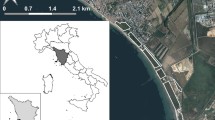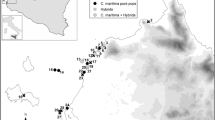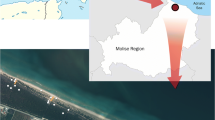Abstract
We surveyed plant species composition and distribution in the Tottori Sand Dunes, a strictly protected large coastal dune area of western Japan. We aimed to determine the percentage of species of regional coastal flora that can be maintained, and the relationship between plant species diversity and habitat type, in a large coastal dune reserve. In the Tottori Sand Dunes, we identified 132 vascular plant species, including four endangered species and 20 coastal species. We recorded 36% of Tottori Prefecture’s coastal plants here, suggesting that a protected large coastal dune area that stands alone cannot provide a habitat for all the coastal plant flora at a regional scale. A greater number of coastal plant species were found in the seaside habitat, and it appears that plants more resistant to salt spray and wave action survive there. No plant habitats were found in the main tourist area, which may be a consequence of trampling. The highest number of species was found in the rear dune hollow habitat, whereas that of alien plants was found in the dune hollow habitat. In the dune hollow habitat, weeding during summer may have encouraged the annual invasion of alien plants. This study has shown that plant species diversity is affected by a variety of dune dynamics and also by human impact.






Similar content being viewed by others
References
Bagnold RA (1954) The physics of blown sand and desert dunes. Butler & Tanner, London
Barbour MG (1978) Salt spray as a microenvironmental factor in the distribution of beadh plants at Point Reyes, California. Oecologia (berl.) 32:213–224
Casasola PM (1986) Sand movement as a factor in the distribution of plant communities in a coastal dune system. Vegetation 65:67–76
Ciccarelli D (2014) Mediterranean coastal sand dune vegetation: influence of natural and anthropogenic factor. Environ Manage 54:194–204
Fenu G, Cogoni D, Ulian T, Bacchetta G (2013) The impact of human trampling on a threatened coastal Mediterranean plant: the case of Anchusa littorea Moris (Boraginaceae). Flora 208:104–110
Ishida H, Hattori T, Kodate S (2001) Relationship between species richness, species composition and forest area of fragmented lucidophyllous forests in Japan seaside region. J Phytogeogr Taxon 49:149–161 (in Japanese with English abstract)
Ishikawa S (2014) Three comments for promoting conservation of coastal sand dune vegetation. Landsc Ecol Manage 19:51–56 (in Japanese with English abstract)
Ishikawa S, Furukawa A, Oikawa T (1995) Zonal plant distribution and edaphic and micrometeorological conditions on a coastal sand dune. Ecol Res 10:259–266
Kiyosue T (1983) The physicochemical properties, animals and plants in sand dunes: plants. Sand Dune Res 30:67–76 (in Japanese)
Kodama Y (2012) Oigo-suribachi. In: The Examination Committee of Tottori Sand Dunes (ed) Tottori Sand Dunes ‘Marugoto’ handbook. Imaishoten, Tottori, pp 29–31
Kollmann J, Jensen KB, Frandsen SI, Hansen MK (2011) Uprooting and burial of invasive alien plants: a new tool in coastal restoration? Restor Ecol 19:371–378
Kusunose Y, Ishikawa S (2014) Spatial distribution patterns of coastal plants along sandy beaches restored by offshore breakwaters in west Japan. Veg Sci 31:1–17 (in Japanese with English abstract)
Levin N, Kidron GJ, Ben-Dor E (2008) A field quantification of coastal dune perennial plants as indicators of surface stability, erosion or deposition. Sedimentology 55:751–772
Martinez ML, Psuty NP, Lubke RA (2004) A perspective on coastal dunes. In: Martinez ML, Psuty NP (eds) Coastal dunes: ecology and conservation. Springer, Heidelberg, pp 3–10
Ministry of the Environment (2015) List of the alien species that are likely to cause damages pertaining to the ecosystem. http://www.env.go.jp/nature/intro/2outline/list/list.pdf. Accessed 5 Feb 2017 (in Japanese)
Miyawaki A (1994) New revised edition handbook of Japanese vegetation. Shibundo, Tokyo
Nagamatsu D (2014) Vegetation change and human impacts in Tottori sand dunes during last 60 years. Landsc Ecol Manage 19:15–24 (in Japanese with English abstract)
Nagamatsu D, Sakata S, Yatagai S (2016) Records of Ophioglossum thermale var. thermale in Tottori Sand Dunes and Veronicastrum axillare and Blyxa japonica in Tottori Prefecture. Nat Hist Res San’in 12:22–25 (in Japanese)
Nobuhara H, Toyohara M (1964) Observation on the damages of the coastal vegetation. II. J Ecol Soc Jpn 14:195–200
Ogura A, Yura H (2008) Effects of sandblasting and salt spray on inland plants transplanted to coastal sand dunes. Ecol Res 23:107–112
Oka K, Yoshizaki S, Kobori H (2008) Factors for the zonation of coastal vegetation on the Enshu-nada coast, Shizuoka Prefecture. J Jpn Soc Reveg Technol 34:57–62 (in Japanese with English abstract)
Onimaru M, Kojima H, Katsuno T (2010) Experimental study on restoration and attention of the aquatic endangered plant species Penthorum chinense. J Jpn Soc Reveg Technol 36:155–158 (in Japanese)
Otsuki K, Okada S, Kamichika M, Tamai S (1999) Development and conservation of Tottori Sand Dune. J Agric Eng Soc Jpn 67:31–36 (in Japanese)
R Core Team (2016) R: a language and environment for statistical computing. R Foundation for Statistical Computing, Vienna. URL https://www.R-project.org/
Rickard CA, McLachlan A, Kerley GIH (1994) The effects of vehicular and pedestrian traffic on dune vegetation in South Africa. Ocean Coast Manage 23:225–247
Santoro R, Jucker T, Prisco I, Carboni M, Battisti C, Acosta ATR (2012) Effects of trampling limitation on coastal dune plant communities. Environ Manage 49:534–542
Sasaki T, Koyama A, Koyanagi T, Furukawa T, and Uchida K (2015) Data Analysis of Plant Community Structure and Diversity. Kyoritsu Shuppan, Tokyo (in Japanese)
Sawada Y (2014) The listing status to red lists and the problems to conservation of coastal sand dune plants in Japan. Landsc Ecol Manage 19:25–34 (in Japanese with English abstract)
Sawada Y, Nakanishi H, Oshida K, Hattori T (2007) A check list of coastal plants in Japan. Hum Nat 17:85–101 (in Japanese with English abstract)
Schlacher TA, Dugan J, Schoeman DS, Lastra M, Jones A, Scapini F, Mclachlan A, Defeo O (2007) Sandy beaches at the brink. Divers Distrib 13:556–560
Seer FK, Irmler U, Schrautzer J (2015) Effects of trampling on beach plants at the Baltic Sea. Folia Geobot 50:303–315. doi:10.1007/s12224-015-9230-z
Shimizu H (1991) The current state investigation regarding the increase of plants in Tottori Sand Dunes. In: The Investigation Committee of Current State in Tottori Sand Dunes (ed) The report of current state in Tottori Sand Dunes, Sanin-kaigan National Park. The Investigation Committee of Current State in Tottori Sand Dunes, Tottori, pp 14–24
Shimizu T (2003) Naturalized plants of Japan. Heibonsha, Tokyo
Shimizu H, Nagata H (1980) Vegetation in Tottori Sand Dune with notes on its conservation. In: Tottori City board of education (ed) The special investigation report of Tottori Sand Dunes. Tottori City Board of Education, Tottori, pp 48–64
Smith WG (1913) Raunkiaer’s “life-forms ” and statistical methods. J Ecol 1:16–26
Takeda S (2010) The distribution of Viola L. in rural area of Iwate Prefecture and the influence of the difference of management on the population density of Viola spp. Bull Iwate Agric Res Cent 10:1–11 (in Japanese with English summary)
Tottori Biological Society (ed) (2012) Red data book in Tottori, 2nd edn. Tottori Biological Society, Tottori
Usami Y, Koizumi H, Sato M (1990) Processes of secondary succession on fallow land in relation to management systems. Weed Res 35:74–80 (in Japanese with English summary)
Usami Y, Koizumi H, Sato M (1992) Effects of plowing and herbicide application on vegetation dynamics in abandoned upland fields. Weed Res 37:283–289 (in Japanese with English summary)
Vecchio SD, Pizzo L, Buffa G (2015) The response of plant community diversity to alien invasion: evidence from a sand dune time series. Biodivers Conserv 24:371–392
Wiedemann AM, Pickart AJ (2004) Temperate zone coastal dunes. In: Martinez ML, Psuty NP (eds) Coastal dunes: ecology and conservation. Springer, Heidelberg, pp 53–65
Yamana I (1955) Tottori Sand-Dune Area, its geomorphological description with evolution aspect. J Geogr 64:7–10 (in Japanese with English summary)
Yonemura S, Nasu M, Tazawa R, Matsubara T, Kameyama A (1999) restoration of a vulnerable species Penthorum chinedse population in a regulation reservoir. J Jpn Soc Revege Technol 25:317–320 (in Japanese with English abstract)
Yura H, Kaihatsu N (2008) The coastal white paper about plants community. The Nature Conservation Society of Japan, Tokyo (in Japanese)
Yura H, Ogura A (2006) Sandblasting as a possible factor controlling the distribution of plants on a coastal dune system. Plant Ecol 185:199–208
Acknowledgments
We are grateful to the Ministry of Environment and Tottori Prefecture for allowing the field survey and supporting this study. The authors thank Mr. Shigetaka Sakata and Drs. Nobuo Tsurusaki and Yoshinori Kodama for helpful comments. We also thank members of the Laboratory of Plant Ecology of Tottori University for support. This work was supported by JSPS KAKENHI Grant no. JP25340109.
Author information
Authors and Affiliations
Corresponding author
Ethics declarations
Conflict of interest
The authors declare that they have no conflict of interest.
Rights and permissions
About this article
Cite this article
Iwasato, M., Nagamatsu, D. Plant species diversity and habitat conditions in a protected large coastal dune area of western Japan. Landscape Ecol Eng 14, 99–113 (2018). https://doi.org/10.1007/s11355-017-0334-x
Received:
Revised:
Accepted:
Published:
Issue Date:
DOI: https://doi.org/10.1007/s11355-017-0334-x




